 "No, I don't thank you for the fish at all" (notindetroit)
"No, I don't thank you for the fish at all" (notindetroit)
12/20/2015 at 20:00 • Filed to: planelopnik
 4
4
 3
3
 "No, I don't thank you for the fish at all" (notindetroit)
"No, I don't thank you for the fish at all" (notindetroit)
12/20/2015 at 20:00 • Filed to: planelopnik |  4 4
|  3 3 |
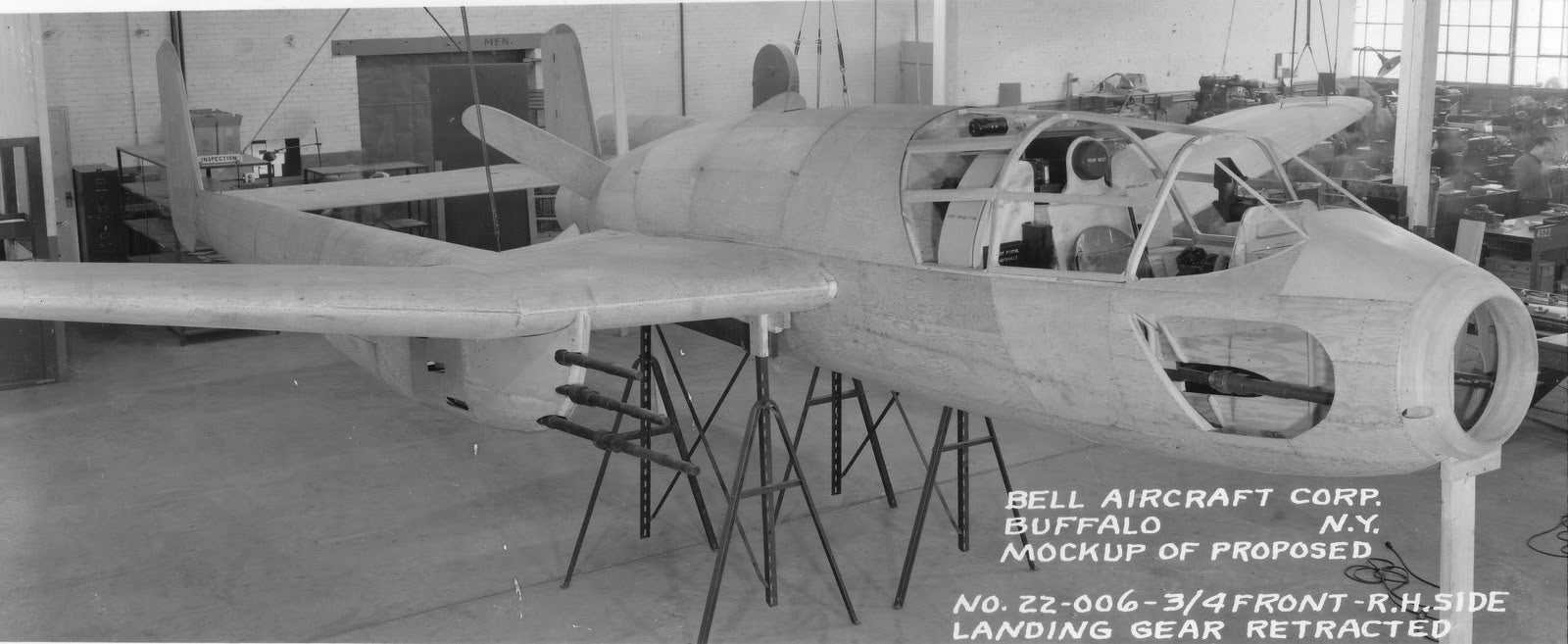
!!!error: Indecipherable SUB-paragraph formatting!!! reminded me of the Bell XP-59, an aircraft that was developed during WWII. If you just do a raw Google Image Search, the pictures you’ll find will be of a radically different aircraft than the one pictured above. Usually the confusion is carefully avoided, but the United States Army Air Force made a deliberate exception in order to disguise the top-secret development of a jet aircraft they hope would out-perform other nation’s similar efforts. Unfortunately, that aircraft turned out to be a disappointment. Oddly enough, they might’ve had a suitable ready-made jet aircraft if they had adapted the original name holder.
Topshot from Thomas “Tommy” Thompson’s !!!error: Indecipherable SUB-paragraph formatting!!! blog
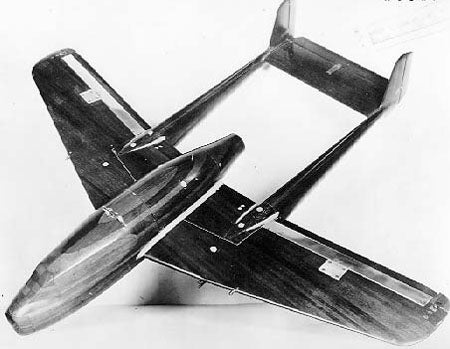
In the late 1930s the Bell Aircraft Company conducted a study that the USAAF designated the XP-52. It was for a single-seat fighter/interceptor aircraft with an unusual configuration - the propeller would be behind the fuselage, tucked in between two booms that held the aircraft’s rear control surfaces, similar to a Lockheed P-38 Lightning but with half the engines. The wings were broad and lightly swept, not entirely an unusual configuration of the time (the most popular airline of the day, !!!error: Indecipherable SUB-paragraph formatting!!! has a similar wing planform). But perhaps the most unusual feature of the aircraft was the large hole running right through the center, giving the plane a giant gaping maw like a fish swimming through the air. This was to be an air inlet for the water-cooled engine’s radiator. The XP-52 went nowhere for reasons that I have not been able to clarify, but the design was refined into the XP-59 that retained the same disgintuishing features.
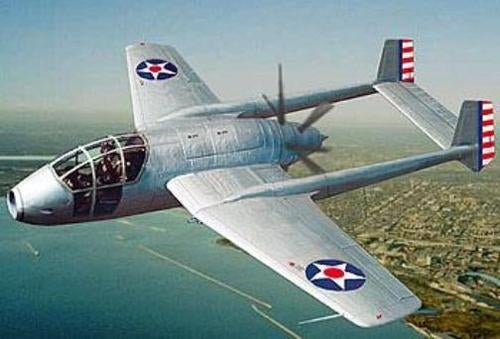
Artist’s depiction of the original XP-52 design study, from !!!error: Indecipherable SUB-paragraph formatting!!!
The XP-59 was shopped to the Navy who was interested in using it from their aircraft carriers, but selected Grumman’s G51 design instead, later adopted as the !!!error: Indecipherable SUB-paragraph formatting!!! , an exceptionally powerful combat aircraft for its day (albeit quickly supplanted by jets). The XP-59 was likely rejected because the rear counter-rotating propeller arrangement made striking carrier decks a far too frequent possibility. The XP-59 was also rejected by the USAAF, likely because of the prevailing attitude at the time of preferring designs that were already in production and thus guaranteed readily available to fight Hitler and Tojo (the top brass had been paralized into fear from Hitler’s successful Blitzkreig across Europe, concluding that they needed to produce aircraft as fast as possible to provide an effective counter). By the time this fear subsided, jet designs that would eventually become the F-86 Sabre and F9F Panther were already being prototyped, and the handwriting was on the wall for propeller aircraft. In fact, the designation XP-59 would later be reused to mask Bell’s own jet aircraft development.
Unfortunately, the aircraft that would actually fly as !!!error: Indecipherable SUB-paragraph formatting!!! , or the “Airacomet,” proved to be an absolute dog of an airplane. Although mass-production ready, the USAAF wasn’t convinced it would’ve provided the necessary performance improvement over the existing P-38s, P-47s and P-51s that were ripping the Luftwaffe to shreds, Hitler’s “Wunderwaffe” Me-262 jet included. The USAAF ordered basically just enough P-59s to provide experimentation and data to develop more effective fighter aircraft and to provide the training necessary to teach pilots how to operate a jet-powered aircraft.
And yet...
A viable jet aircraft design may have been staring at them in the face all along, with the design that bore the original XP-59 designation. The unique radiator-in-the-nose design already made the plane reminiscient of the F-86 and MiG-15 jets that would duke it out over Korea. The podded, stubby fuselage was accidentally already suitable for the Sir Frank Whittle-designed centrifugal-flow jet engines, something the British would demonstrate on their later !!!error: Indecipherable SUB-paragraph formatting!!! . One has to wonder if they had merely dumped the original piston engine and put a jet in its place ala what SAAB had done with their J-21 jet fighter. At the very least, it couldn’t have been any worse than the rather uninspired Airacomet.
 ttyymmnn
> No, I don't thank you for the fish at all
ttyymmnn
> No, I don't thank you for the fish at all
12/20/2015 at 22:08 |
|
An interesting proposal, to be sure. But even if Bell had continued with the XP-59, it’s quite possible that the propeller plane would have outperformed the Airacomet. Propeller design was reaching its zenith, while jets were still in the cradle. The XP-59 was expected to have a top speed of 450 mph (the Airacomet managed 404 mph). And while it took the Airacomet 15 minutes to climb to 30k feet, the XP-59 would have rivaled that, making 20k feet in 6 minutes. Of course, there’s no way of knowing if those numbers would have been right. Designers have a way of overstating performance numbers before an aircraft flies. I think that American designers really had no idea what to do with the new jets. They basically took everything they knew about propeller planes and just threw a turbojet into them. Look at the
Vought F6U Pirate
. It was even worse than the Airacomet.
 Drakkon- Most Glorious and Upright Person of Genius
> No, I don't thank you for the fish at all
Drakkon- Most Glorious and Upright Person of Genius
> No, I don't thank you for the fish at all
12/20/2015 at 23:04 |
|
More freaking guns!!!
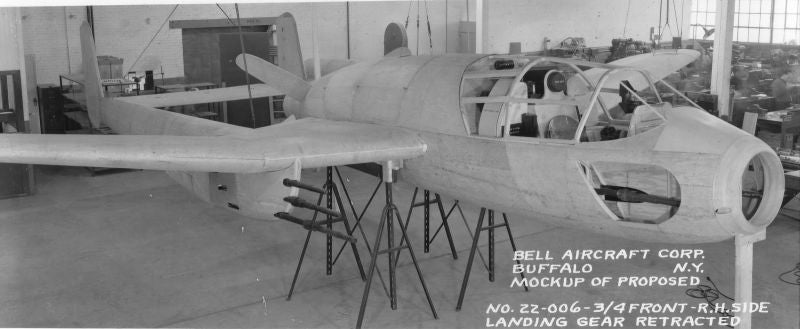
 gmporschenut also a fan of hondas
> No, I don't thank you for the fish at all
gmporschenut also a fan of hondas
> No, I don't thank you for the fish at all
12/22/2015 at 00:17 |
|
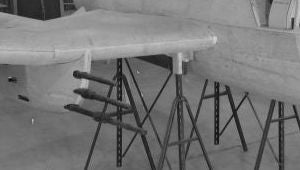
Someone would have been in for a world of hurt.